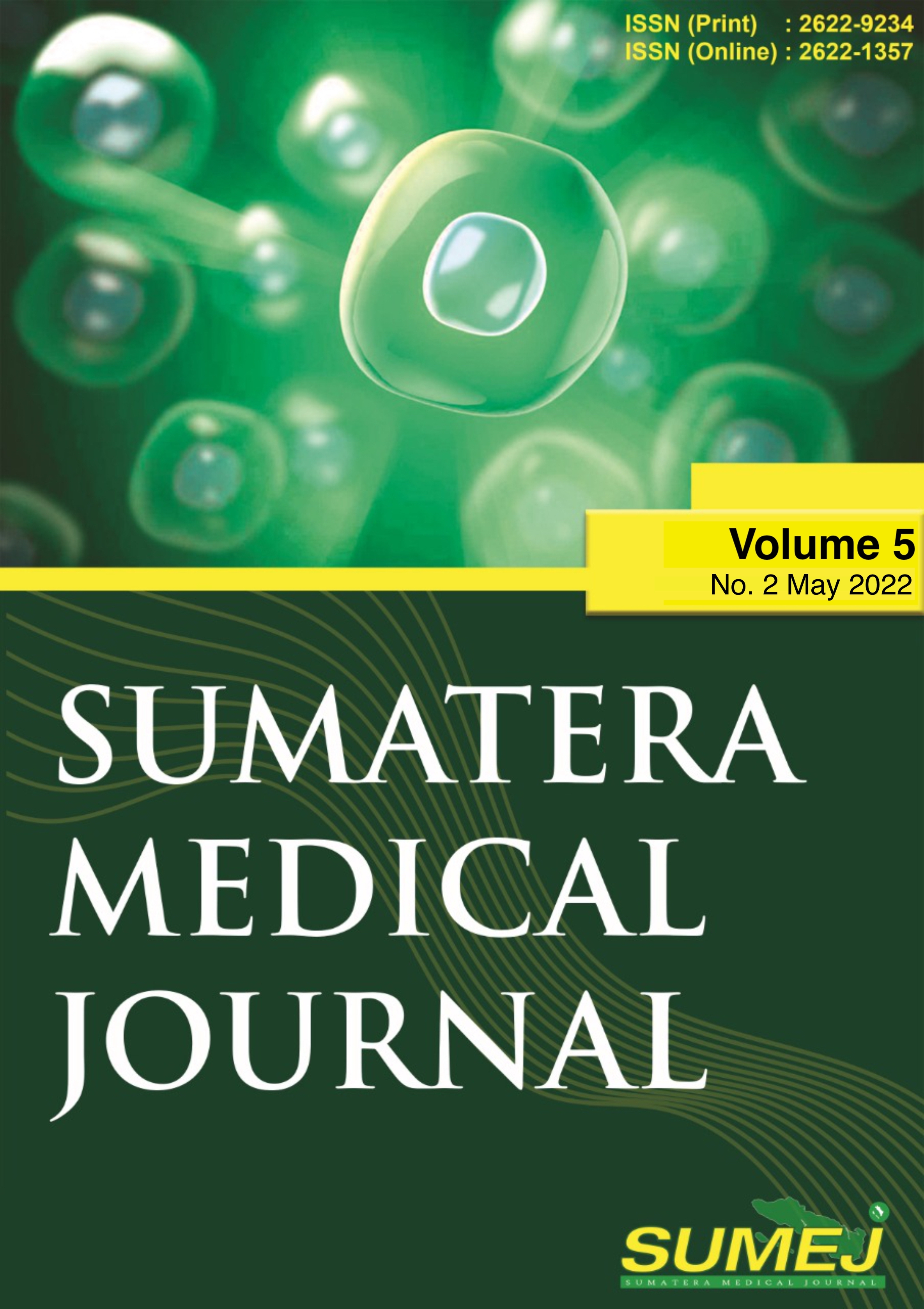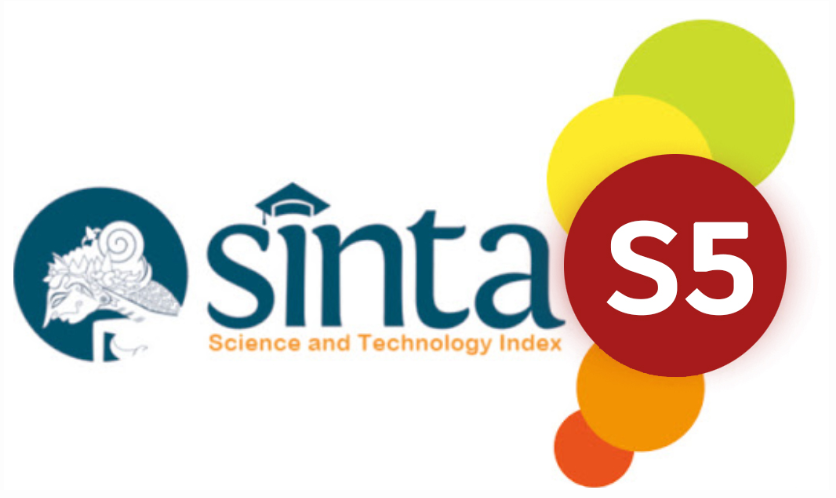A Case Report The Evaluation of Malondialdehyde Level on Acne Vulgaris Treatment
DOI:
https://doi.org/10.32734/sumej.v5i2.6633Keywords:
Acne vulgaris, Oxidative Stres, MalondialdehydeAbstract
Abstract: Acne vulgaris (AV) is a multifactorial disease of the pilosebaceous unit with varying degrees of severity, recurrent and characterized by polymorphic lesions. Recent studies have found that the etiopathogenesis of AV is caused by oxidative stress. Each factor that causes AV is interrelated and is under the control of hormones and immunity. Measurement of malondialdehyde (MDA) level in the blood becomes a biological marker or an indicator of cell and tissue damage caused by oxidative stress. Case: A 23-years-old female private employee visited the clinic for multiple comedones and papulopustular lesions scattered over cheeks, nose, and chin that spread to the whole face four months ago. There were multiple comedones, papules, pustules, nodules on the maxillary, nasalis, left and right zigomatic, mentalis and frontalis region. We also found multiple scars on the left and right buccal. She was diagnosed with Severe AV. Serum MDA level was measured according to the enzyme-linked immunosorbent assay (ELISA) method before and after therapy. She was treated with doxycycline 100 mg, 0.025% tretinoin cream, 5% benzoyl peroxide, 1.2% clindamycin gel, and broadspectrum sunscreen with SPF 50. Result: After eight weeks of treatment, there were noticeable improvements in acne lesions and overall healthier-looking skin. Serum MDA levels are decreased (22.6 nmol/ml to 17.9 nmol/ml) as the impact of the therapy.
Keyword: Acne Vulgaris, Malondialdehyde, Oxidative Stress
Downloads
References
C. Goh, C. Cheng, G. Agak, A. Zaenglein, E. Graber, D. Thiboutot and J. Kim, "Acneiformis disorder," in Fitzpatrick's Dermatology in General Medicine., 9th ed., S. Kang, M. Amagai, A. Bruckner, A. Enk, D. Margolis, A. McMichael, and J. Orringer, Ed. New York: McGraw Hill Companies, 2019, pp. 1391-1418.
A. Layton, E. Eady, and C. Zoubolis, "Acne," in Rook's textbook of dermatology, 9th ed., T. Burns, S. Breathnach, N. Cox, and C. Griffiths, Ed. Blackwell Science Ltd, 2016, pp. 901-50.
D. Lynn, T. Umari, R. Dellavalle, and C. Dunnick, "The epidemiology of acne vulgaris in late adolescence," Adolescent Health, Medicine and Therapeutics, p. 13, 2016.
N. K. Jusuf, I. B. Putra, and N. K. Dewi, “Antibacterial Activity of Passion Fruit Purple Variant (Passiflora edulis Sims var. edulis) Seeds Extract Against Propionibacterium acnes,†Clin. Cosmet. Investig. Dermatol., vol. 13, pp. 99–104, 2020.
N. K. Jusuf, I. B. Putra, and A. R. Sutrisno, “Correlation between stress scale and serum substance P level in acne vulgaris,†Int. J. Gen. Med., vol. 14, pp. 681–686, 2021.
A. Tamba and N. K. Jusuf, "The Association Between Skin Types and Acne Vulgaris," Sumatera Medical Journal (SUMEJ, vol. 3, no. 1, pp. 34-40, 2020 [Online]. Available: https://talenta.usu.ac.id/smj/. [Accessed: 30- June- 2021]
D. Castillo, S. Nanda, and J. Keri, "Propionibacterium (Cutibacterium) acnes Bacteriophage Therapy in Acne: Current Evidence and Future Perspectives," Dermatology and Therapy, vol. 9, no. 1, pp. 19-31, 2018.
N. K. Jusuf, I. B. Putra, and L. Sari, “Differences of microbiomes found in non-inflammatory and inflammatory lesions of acne vulgaris,†Clin. Cosmet. Investig. Dermatol., vol. 13, pp. 773–780, 2020.
E. Makrantonaki, R. Ganceviciene, and C. Zouboulis, "An update on the role of the sebaceous gland in the pathogenesis of acne," Dermato-Endocrinology, vol. 3, no. 1, pp. 41-49, 2011.
S. Anggraeni, T. Setyaningrum and M. Yulianto Listiawan, "Perbedaan Kadar Malondialdehid (MDA) sebagai Petanda Stres Oksidatif pada Berbagai Derajat Akne Vulgaris", Berkala Ilmu Kesehatan Kulit dan Kelamin - Periodical of Dermatology and Venereology, vol. 29, no. 1, pp. 36-43, 2017.
N. Trivedi, Z. Cong, A. Nelson, A. Albert, L. Rosamilia, S. Sivarajah, K. Gilliland, W. Liu, D. Mauger, R. Gabbay, and D. Thiboutot, "Peroxisome Proliferator-Activated Receptors Increase Human Sebum Production", Journal of Investigative Dermatology, vol. 126, no. 9, pp. 2002-2009, 2006.
Madkour, The roles and mechanisms of ROS, oxidative stress, and oxidative damage. Nanoparticles Induce Oxidative and Endoplasmic Reticulum Stresses. Springer International Publishing, 2020, pp. 139-91.
A. Ayala, M. Muñoz and S. Argüelles, "Lipid Peroxidation: Production, Metabolism, and Signaling Mechanisms of Malondialdehyde and 4-Hydroxy-2-Nonenal", Oxidative Medicine and Cellular Longevity, vol. 2014, pp. 1-31, 2014.
A. Mahmoud, M. Gaber and A. Dawood, "Oxidants and antioxidants role in acne vulgaris", Menoufia Medical Journal, vol. 27, no. 2, p. 465, 2014.
G. Sarici, S. Cinar, F. Armutcu, C. Altnyazar, R. Koca and N. Tekin, "Oxidative stress in acne vulgaris", Journal of the European Academy of Dermatology and Venereology, vol. 24, no. 7, pp. 763-767, 2009.
R.S. Sutanto, "Derajat penyakit akne vulgaris berhubungan positif dengan kadar MDA", Tesis Program Pascasarjana, Universitas Udayana, 2013.
F. Puspita, "Perbedaan kadar malondialdehid plasma pada berbagai derajat keparahan akne vulgaris", Tesis Profesi Program Pendidikan Dokter Spesialis Dermatologi dan Venereologi, Universitas Sumatera Utara, 2020.
A. Sahib, H. AlAnbari, and A. Raghif, "Oxidative stress in acne vulgaris: an important therapeutic target," J. Mol. Pathophysiol., vol. 2, no. 1, p. 27, 2013.
L. Sari, N. K. Jusuf, and I. B. Putra, “Bacterial identification of acne vulgaris,†Bali Med. J., vol. 9, no. 3, p. 753, 2020.
Wasitaatmadja SM, Arimuko A, Norawati L, Bernadette I, Legiawati L, Pedoman tata laksana akne di Indonesia. 2th ed. Jakarta: Kelompok Studi Dermatologi Kosmetik Indonesia. Perhimpunan Dokter Spesialis Kulit dan Kelamin Indonesia, 2015.
S. S. Kolli, D. Pecone, A. Pona, A. Cline, and S. R. Feldman, "Topical retinoids in acne vulgaris: A systematic review," Am. J. Clin. Dermatol., vol. 20, no. 3, pp. 345-365, 2019.
Jha A, Barkham T, Chan SP, Tan AWH, Tang MBY, Tan HH, et al., Antibiotic Sensitivity of Cutibacterium acnes Isolates from Acne Patients in a Skin Hospital in Singapore, vol. 10, no. 1000484. J Clin Exp Dermatol Res, 2019.
A. Antonio, M. F., and A. Sandro, "Lipid Peroxidation: Production, Metabolism, and Signaling Mechanisms of Malondialdehyde and 4-Hydroxy-2-Nonenal," Oxidative Medicine and Cellular Longevity, vol. 360438, p. 31, 2014.
M. D. Linsley, F. J. Ekinci, D. Ortiz, E. Rogers, and T. B. Shea, "Monitoring thiobarbituric acid-reactive substances (TBARs) as an assay for oxidative damage in neuronal cultures and central nervous system," J Neurosci Methods, vol. 141, no. 2, 2005.
B. Zhang et al., "Toll-like receptor 2 plays a critical role in pathogenesis of acne vulgaris," Biomed. dermatol., vol. 3, no. 1, 2019, doi: 10.1186/s41702-019-0042-2.
S. Kardeh, S. A. Moein, M. R. Namazi, and B. Kardeh, "Evidence for the important Role of oxidative stress in the pathogenesis of acne," Galen, vol. 8, p. 1291, 2019.
N. R. Trivedi et al., "Peroxisome proliferator-activated receptors increase human sebum production," J. Invest. Dermatol., vol. 126, no. 9, pp. 2002-2009, 2006.
A. Yorulmaz Demir, A. Metin, S. Iikolu, and Ö. Erel, "The effect of isotretinoin on oxidative stress in severe acne vulgaris patients," Turk. Klin. J. Med. Sci., vol. 32, no. 4, pp. 1026-1031, 2012.
B. C. Melnik, "The role of mTORC1 in acne pathogenesis and treatment," Expert Rev. Dermatol., vol. 8, no. 6, pp. 617-622, 2013.
Published
How to Cite
Issue
Section
License
Copyright (c) 2022 Sumatera Medical Journal

This work is licensed under a Creative Commons Attribution-NonCommercial-NoDerivatives 4.0 International License.
The Authors submitting a manuscript do so on the understanding that if accepted for publication, copyright of the article shall be assigned to Sumatera Medical Journal (SUMEJ) and Faculty of Medicine as well as TALENTA Publisher Universitas Sumatera Utara as publisher of the journal.
Copyright encompasses exclusive rights to reproduce and deliver the article in all form and media. The reproduction of any part of this journal, its storage in databases and its transmission by any form or media, will be allowed only with a written permission from Sumatera Medical Journal (SUMEJ).
The Copyright Transfer Form can be downloaded here.
The copyright form should be signed originally and sent to the Editorial Office in the form of original mail or scanned document.











